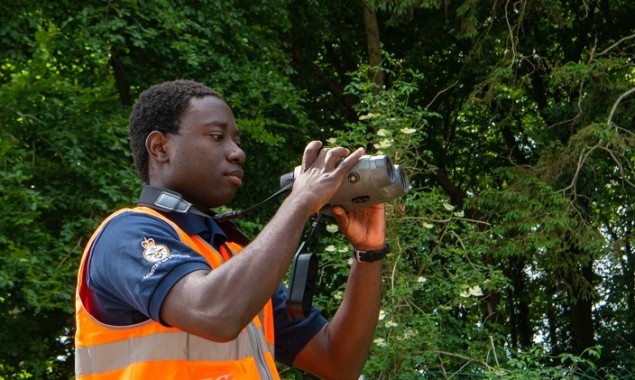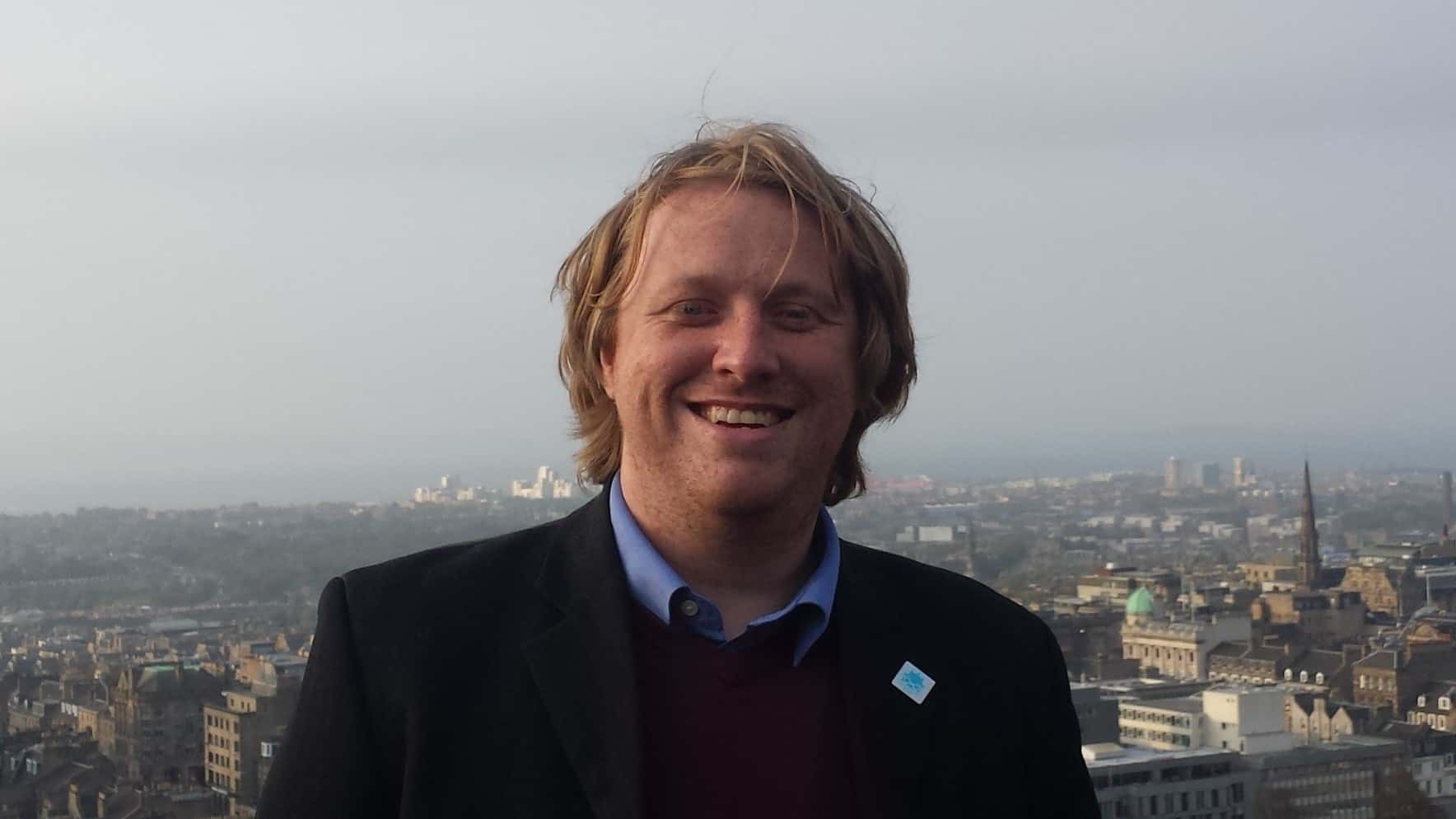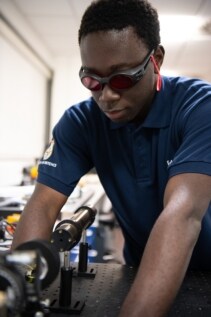Extra funding for science and technology at the UK’s Ministry of Defence has created an urgent need for physicists as well as scientists and engineers from all backgrounds

In 2020, as part of a comprehensive review of defence spending, the UK government underlined the strategic importance of science and technology for national defence and security. The review earmarked an additional £6bn for research and development at the Ministry of Defence (MoD) over the next four years, with an extra £1.1bn allocated to so-called pull-through activities – ensuring that innovations designed initially for the military lead to wider applications in the commercial sector.
That extra funding has led to a major recruitment drive at the Defence Science and Technology Laboratory (Dstl), the scientific division of the MoD. Hundreds of positions for scientists, engineers and project managers need to be filled over the next few months, with more to follow in 2022. In the vanguard are 70 vacancies that are now being advertised for physicists at all stages of their careers, while one of Dstl’s dedicated graduate programmes is also doubling its intake of physicists, up from around 15–20 per year to 40 new graduate positions in both 2021 and 2022.
The skill set offered by physicists is needed for a lot of our current vacancies.
Karen Smith, a talent acquisition and planning adviser at Dstl
“The skill set offered by physicists is needed for a lot of our current vacancies, which need expertise in areas such as lasers, electro-optics and electromagnetic phenomena,” says Karen Smith, a talent acquisition and planning adviser at Dstl. “Focusing on the physicist role in our first tranche of recruitment will build a solid foundation for building up our capabilities in other areas.” All in all, the recruitment drive represents an uplift of around 10% in Dstl’s ranks of scientists and engineers – which already stands at more than 3000 members of staff.

Mark Pickering, a physicist who has worked at Dstl since 2012, stresses the importance of his scientific training for his role as the UK’s technical lead for close-combat guided weapons systems. “I do a lot of work on missile subsystems such as sensors, aerodynamics and rocket physics, and as a result I directly use my physics knowledge and skills to solve a huge variety of physics-based problems,” he says. “It means that I can predict how something might behave from basic principles, and what to investigate as part of the experiment design.”
[At Dstl] you gain a deeper understanding of something, and it’s more satisfying to build up that understanding from scratch.
Omar Sarsah, Dstl
Omar Sarsah, who joined Dstl a couple of years ago as a new physics graduate, has also enjoyed translating the abstract ideas he learnt during his degree into real-world situations. “It turns out that a helicopter has an almost perfect black-body curve, but you have to compensate for various factors, such as the atmosphere and the camera you use to detect the emission,” he explains. “These are all things that you study separately at university, but here you get to put them together. You gain a deeper understanding of something, and it’s more satisfying to build up that understanding from scratch.”
One of the key attractions for both Pickering and Sarsah is the ability to contribute to a variety of different projects. Sarsah, who specializes in electro-optics, might work on several projects at a time – which might involve anything from electronics to highly sensitive quantum-optical systems. For the most part, however, he uses his specific knowledge of cameras and optical modelling to evaluate and improve the performance of different systems or platforms. In the case of the helicopter, this type of analysis revealed that the engine generates bright emission in the infrared, which prompted the use of engine covers to improve stealth and, ultimately, the safety of military personnel.
“You are presented with a problem that no one has yet solved, you think about the best way to tackle it, and then you put it to the test,” explains Pickering. “It’s really rewarding to be involved throughout the entire process of turning what might be quite a nebulous idea into something that makes a real difference.”
As an example, Pickering describes how he was recently trialling some new equipment that needed to be tested onboard a flying aircraft. “I was in a control room directing what trials the aircraft should be doing, all following my experimental plan,” he says. “It was the magical fulfilment of seeing something you’ve worked on for several years coming to fruition. It was an amazing feeling.”
Seeing something you’ve worked on for several years coming to fruition was an amazing feeling.
Mark Pickering, Dstl
An essential part of this project work is the need to join forces with scientists and engineers with different backgrounds and skill sets. “We need to develop things that people can use, and so everyone needs to work together to make sure each element interacts with everything else in the system,” comments Sarsah. “I might be able to design parameters for a specific camera, but when it needs to be integrated into a real-world system we also need to make sure the electronics line-up, that the mechanical stability is fine – and even that it goes in the right way round.”
Close collaboration is also needed with research teams in industry and academia, something that will become even more important with the extra funding for R&D. Pickering already acts as a technical partner on several of these collaborative projects, providing technical expertise and ensuring that any external research meets the objectives set by the MoD. He also serves as the technical lead on several procurement programmes, providing scientific advice to government and front-line commands, and fulfils a similar role with international organizations.
Newer members of staff also have plenty of opportunities to gain different experiences and to get involved with external collaborations. Pickering started his career on secondment to a naval base, and one of his graduates is just about to start a six-month placement with one of Dstl’s industry partners. Meanwhile, Sarsah regularly works off-site, gathering test data from aircraft or from ballistic systems being fired on an outdoor range, and currently sits on one of NATO’s technical panels. He is now considering various options for progressing his career at Dstl, which could include a secondment in the UK or overseas, a move to the MoD headquarters in Whitehall, or studying part-time for a PhD.
From prior experience, Pickering says that it’s incredibly easy to switch domains or to move around the organization. While his sights are now firmly focused on a technical career path, scientists and engineers employed by Dstl can also choose to specialize in people management, project management or operational analysis – which seeks to optimize the performance of a whole system rather than each specific element. “Technical and analytical are pretty interchangeable, and lots of people fly back and forth between the two,” comments Pickering.
Anyone thinking of joining Dstl should not be concerned that they do not have enough knowledge of the technologies they will be working with. “No-one is expected to have direct expertise of these systems because the work you will be involved with is so unique,” says Sarsah. ” I spent two weeks at the Defence Academy in Shrivenham when I started, and other courses and seminars are arranged to help you understand the domain you are working in. You also learn lots of things very quickly by doing project work.”
There is also plenty of support for both new and experienced employees. When he started Sarsah was the only member of his team with expertise in optical modelling, and he was overwhelmed with the amount of work that was coming his way. “My team leader helped to organize which projects took priority,” he says. “She stood by me and said that I couldn’t do everything.”

Sarsah was also surprised and delighted that his team nominated him for a NATO early-career award. “When you start out you can be a bit nervous because you don’t know everything and there’s so much knowledge and expertise around,” he says. “Although I didn’t win the award, it showed me that I was making a valuable contribution to the team.”
Pickering has also been impressed with the help and support that Dstl offers to its employees. He is extremely dyslexic, particularly when it comes to writing, and Dstl has always ensured that additional systems and resources are available to help review and refine his written work. “I have always been impressed at how far they are willing to go to look after people,” he comments. “Dstl really cares about its employees.”
That level of support makes Dstl an open and inclusive place to work. Internal support networks, run by employees for other employees with similar interests and needs, help staff to discuss problems, share advice, and raise any issues with the executive team. Fully flexible working is also available as standard, including alternative working patterns, job share, and variable working hours. “We want all our employees to maximize their potential,” comments Smith.
For their part, it’s clear Pickering and Sarsah are primarily motivated by the diverse opportunities they have to learn new science and new skills, and to work on projects that have a real impact on people’s lives. “It’s been the best job I could ever ask for,” says Pickering. “I’ve really enjoyed everything I’ve done while I have been at Dstl.”
• Some of the names in this article have been changed for privacy reasons.



